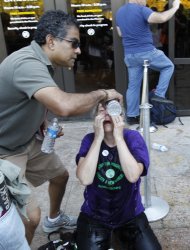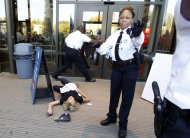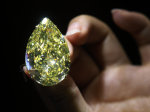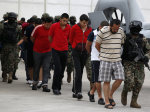OAKLAND, Calif. (AP) — Al Davis, the Hall of Fame owner of the Oakland Raiders known for his rebellious spirit, has died.
The team announced his death at age 82 on Saturday. It was not immediately clear when and where he died.
It was Davis' willingness to buck the establishment that helped turn the NFL into THE establishment in sports — the most successful sports league in American history.
Davis was charming, cantankerous and compassionate — a man who when his wife suffered a serious heart attack in the 1970s moved into her hospital room. But he was best known as a rebel, a man who established a team whose silver-and-black colors and pirate logo symbolized his attitude toward authority, both on the field and off.
Davis was one of the most important figures in NFL history. That was most evident during the 1980s when he fought in court — and won — for the right to move his team from Oakland to Los Angeles. Even after he moved them back to the Bay Area in 1995, he went to court, suing for $1.2 billion to establish that he still owned the rights to the L.A. market.
Until the decline of the Raiders into a perennial loser in the first decade of the 21st century he was a winner, the man who as a coach, then owner-general manager-de facto coach, established what he called "the team of the decades" based on another slogan: "commitment to excellence." And the Raiders were excellent, winning three Super Bowls during the 1970s and 1980s and contending almost every other season — an organization filled with castoffs and troublemakers who turned into trouble for opponents.
Davis, elected in 1992 to the Pro Football Hall of Fame, also was a trailblazer. He hired the first black head coach of the modern era — Art Shell in 1988. He hired the first Latino coach, Tom Flores; and the first woman CEO, Amy Trask. And he was infallibly loyal to his players and officials: to be a Raider was to be a Raider for life.
But it was his rebellious spirit, that willingness to buck the establishment, that helped turn the NFL into THE establishment in sports — the most successful sports league in American history. He was the last commissioner of the American Football league and led it on personnel forays that helped force a merger that turned the expanded NFL into the colossus it remains.
Born in Brockton, Mass., Davis grew up in Brooklyn and graduated from Erasmus Hall High School, a spawning ground in the two decades after World War II for a number of ambitious young people who became renowned in sports, business and entertainment. Davis was perhaps the second most famous after Barbra Streisand.
"We had a reunion in Los Angeles and 500 people showed up, including Bah-bruh," he once told an interviewer in that combination of southern drawl/Brooklynese that was often parodied among his acquaintances within the league and without.
A graduate of Syracuse University, he became an assistant coach with the Baltimore Colts at age 24; and was an assistant at The Citadel and then Southern California before joining the Los Angeles Chargers of the new AFL in 1960. Only three years later, he was hired by the Raiders and became the youngest general manager-head coach in pro football history with a team he called "the Raid-uhs" in 1963.
He was a good one, 23-16-3 in three seasons with a franchise that had started its life 9-23.
Then he bought into the failing franchise, which played on a high school field adjacent to the Nimitz Freeway in Oakland and became managing general partner, a position he held until his death.
But as the many bright young coaches he hired — from John Madden, Mike Shanahan and Jon Gruden to Lane Kiffin — found out, he remained the coach. He ran everything from the sidelines, often calling down with plays, or sending emissaries to the sidelines to make substitutions.
In 1966, he became commissioner of the AFL.
But even before that, he had begun to break an unwritten truce between the young league and its established rivals, which fought over draft choices but did not go after established players.
And while the NFL's New York Giants' signing of Buffalo placekicker Pete Gogolak marked the first break in that rule, it was Davis who began to go after NFL stars — pursuing quarterbacks John Brodie and Roman Gabriel as he tried to establish AFL supremacy.
Davis' war precipitated first talks of merger, although Davis opposed it. But led by Lamar Hunt of Kansas City, the AFL owners agreed that peace was best. A common draft was established, and the first Super Bowl was played following the 1966 season — Green Bay beat Kansas City, then went on to beat Davis' Raiders the next season. By 1970, the leagues were fully merged and the league had the basic structure it retains until this day — with the NFL's Pete Rozelle as commissioner, not Davis, who wanted the job badly.
So he went back to the Raiders, running a team that won Super Bowls after the 1976, 1980 and 1983 seasons — the last one in Los Angeles, where the franchise moved in 1982 after protracted court fights. It was a battling bunch, filled with players such as John Matuszak, Mike Haynes and Lyle Alzado, stars who didn't fill in elsewhere who combined with homegrown stars — Ken Stabler, another rebellious spirit; Gene Upshaw; Shell, Jack Tatum, Willie Brown and dozens of others.
Davis was never a company man. Not in the way he dressed: jump suits with a Raiders logo: white or black, with the occasional black suit, black shirt and silver tie. Not in the way he wore his hair — even well into his '70s it was slicked back with a '50s duck-tail. Not in the way he did business — on his own terms, always on his own terms.
After lengthy lawsuits involving the move to Los Angeles, he went back to Oakland and at one point in the early years of the century was involved in suits in northern and southern California — the one seeking the Los Angeles rights and another suing Oakland for failing to deliver sellouts they promised to get the Raiders back.
But if owners and league executives branded Davis a renegade, friends and former players find him the epitome of loyalty.
When his wife, Carol, had a serious heart attack, he moved into her hospital room and lived there for more than a month. And when he hears that even a distant acquaintance is ill, he'll offer medical help without worrying about expense.
"Disease is the one thing — boy I tell you, it's tough to lick," he said in 2008, talking about the leg ailments that had restricted him to using a walker. "It's tough to lick those diseases. I don't know why they can't."
A few years earlier, he said: "I can control most things, but I don't seem to be able to control death. "Everybody seems to be going on me."
As he aged, his teams declined.
The Raiders got to the Super Bowl after the 2002 season, losing to Tampa Bay. But for a long period after that, they had the worst record in the NFL, at one point with five coaches in six years.
Some of it was Davis' refusal to stay away from the football operation — he would take a dislike to stars and order them benched.
The most glaring example was Marcus Allen, the most valuable player in the 1984 Super Bowl, the last the Raiders won.
For reasons never made clear, Davis took a dislike to his star running back and ordered him benched for two seasons. He released him after the 1992 season, and Allen went to Kansas City.
Davis' only comment: "He was a cancer on the team."
The small incorporated city of Irwindale, 20 miles east of Los Angeles, learned an expensive lesson about dealing with Davis. The city gave the Raiders $10 million to show its good faith in 1988, but environmental issues, financing problems and regional opposition scuttled plans to turn a gravel pit into a $115 million, 65,000-seat stadium. The deposit was nonrefundable, and Irwindale never got a penny back.
When he fired Mike Shanahan in 1988 after 20 games as head coach, he refused to pay him the $300,000 he was owed. When he became coach of the Denver Broncos, Shanahan delighted most in beating the Raiders and Davis. And when Davis fired Lane Kiffin "for cause" in 2008, withholding the rest of his contract, the usually humorless Shanahan remarked:
"I was a little disappointed, to be honest with you. When you take a look at it, I was there 582 days. Lane Kiffin was there 616 days. So, what it really means is that Al Davis liked Lane more than he liked me. I really don't think it's fair. I won three more games, yet he got 34 more days of work. That just doesn't seem right."
But for most of his life, few people laughed at Al Davis.





